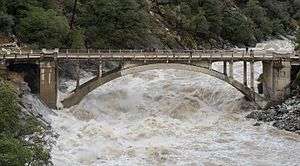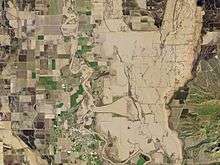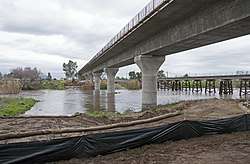2017 California floods
The 2017 California floods were a series of floods that affected parts of California in the first half of 2017. Northern California saw its wettest winter in almost a century, breaking the previous record set in the winter of 1982–83.[5] Flooding related to the same storm systems also impacted parts of western Nevada and southern Oregon. Damage to California roads and highways alone was estimated at over $1.05 billion (2017 USD).[6][4]
 The South Yuba River at Highway 49 floods after heavy rain on January 9, 2017. The flow is about 25,000 cubic feet per second (710 m3/s), more than 40 times the normal rate. | |
| Date | January 7 – February 22, 2017[1][2] |
|---|---|
| Location | California Nevada |
| Deaths | At least 5 directly[3] |
| Property damage | >$1.55 billion (2017 USD)[3][2][4] |
The flooding occurred at the end of one of California's worst droughts on record, and many of the state were unprepared to handle the huge volume of rain and snow, though the heavy precipitation also helped to refill drought-impacted surface water supplies, including many major lakes and reservoirs. The impact on groundwater reserves was limited.[7] Governor Jerry Brown declared the drought officially over on April 4, 2017.[8]
Background
The high-amplitude ridge off the West Coast that characterized the 2011–17 California drought, dubbed the "Ridiculously Resilient Ridge", was replaced by a persistent presence of anomalous troughs impacting California. Another feature in the 2013–2015 winters was the extreme temperature contrast between a warm western U.S. and a cold eastern continent. These anomalous temperature and circulation patterns were referred to as the North American winter “dipole”.[9][10][11] Figure (a) shows the climatological geopotential height (Z) overlaid with its eddy component, in which the dipole centers are located (indicated by X and +). The dipole basically describes the wintertime stationary waves over North America, which contribute to the mean temperature difference between the climatologically warmer western U.S. and colder eastern half. Therefore, an amplification of the stationary wave would enhance such a temperature difference, like in 2013-2015 winters, while a weakening of the stationary wave would reverse the situation, like in 2016–2017 winter.[12] Indeed, in winter 2016–2017 this dipole was apparently reversed.[13]
Effects
Northern California

In early January 2017, the Russian River in Sonoma and Mendocino Counties rose 3 feet (0.91 m) above flood stage, inundating about 500 houses.[14] Over 570,000 customers of the Pacific Gas and Electric Company lost power in Northern and Central California during the event. Over 3,000 people in the Guerneville area were evacuated.[15] The community of Forestville, and the nearby Laguna de Santa Rosa flooded, blocking roads and agricultural lands. Flooding in the Russian River valley inundated vineyards, causing millions of dollars in crop damage.[16]
The American River east of Sacramento reached record flows, although property damage was limited due to flood protection provided by Folsom Dam. The maximum flood release of 70,000 cubic feet per second (2,000 m3/s) was the highest since 1997.[17][18] The popular recreation areas at the American River Parkway and Discovery Park were flooded for four months.[19][20]
On the early morning of February 18, flash flooding on Stone Corral Creek flooded the town of Maxwell in Colusa County.[21] Over 100 residents had to be evacuated by boat after water filled the streets.[22]
Numerous areas in Northern California closed roads to flood and mudslide conditions, with U.S. Route 395 temporarily closed in Mono County heading in both directions.[23]
San Francisco Bay Area
The Anderson Dam in San Jose overflowed in February for the first time in eleven years. The resulting flooding along Coyote Creek forced the evacuation of 14,000 people in San Jose[24][25][26] and caused $73 million in damage.[27] City workers reportedly tried to warn authorities of the flooding risk as much as a day before the river burst its banks, but it remains unclear why evacuations were not ordered until the flooding actually began.[28]
The Puerto Suello Hill Tunnel along the Sonoma–Marin Area Rail Transit line was partially damaged by mudslides; this delayed pre-revenue testing of the system for three weeks.[29]
Oroville Dam spillway failures

On February 7, significant damage occurred at the spillway of Oroville Dam in Butte County. However, due to heavy storm runoff into Lake Oroville, dam operators were forced to continue using the concrete spillway, eventually resulting in the destruction of the lower half of the chute. The reservoir rose so quickly that it overtopped the emergency spillway, which had never been tested for safety, and threatened to undermine it. Over 188,000 people in the Feather River valley were evacuated as officials feared the collapse of the emergency spillway, which could have sent a 30-foot (9 m) wall of water into the Feather River below and flooded communities downstream.
High water flows in the Feather River caused considerable damage, collapsing the river banks and destroying large areas of farmland. The Feather River Fish Hatchery was flooded with turbid water, and several million juvenile salmon had to be evacuated from the facility.
The estimated cost to repair Oroville Dam is $400 million.[30] As of September 2018, the actual cost of repairs had risen to $1.1 billion.[31]
Central California


The San Joaquin River reached its highest levels since 1997, due to the opening of upstream dams to manage flooding, and flood stage was exceeded along portions of the river.[32] On February 20, a levee breached near Manteca, and 500 people were evacuated, though the damage was quickly repaired.[33] Increased flow to the Fresno River, which is normally dry, and the San Joaquin River delayed construction on parts of California High-Speed Rail's Fresno River Viaduct and San Joaquin River Viaduct.[34]
Multiple landslides and bridge collapses in the Big Sur area closed a long stretch of the Pacific Coast Highway, isolating coastal communities. The road is expected to reopen north of Big Sur by September, but a massive landslide about 30 miles (48 km) south of Big Sur may take over a year to clear.[35]
The Pioneer Cabin Tree, a giant sequoia in Calaveras Big Trees State Park, known since 1880 for its man-made "tunnel" that hikers could pass through, was toppled by one of the storms on January 9.[36]
Southern California
Southern California was not as heavily hit as the north; however, storms during February 16–19 were the strongest in seven years. Five people drowned in the Greater Los Angeles urban area as heavy rainfall flooded highways, created sinkholes and cut power to 110,000 households.[37] In Sun Valley water across Interstate 5 was more than 2 and a half feet deep, trapping motorists in their cars. In Orange County, three people were safely rescued from the Santa Ana River, while in Thousand Oaks one man drowned and three others were injured in a flash flood in Arroyo Conejo Creek.[38]
In the Santa Barbara area, flooding closed major roads including Highway 101 and led to debris flows in recently burned areas. Rural mountain communities near Goleta and Solvang were evacuated. The flooding also partially refilled Lake Cachuma, an important local water source which had essentially dried up in the preceding drought.[39]
Other impacts
Dams, reservoirs, and lakes
Dams were opened to relieve pressure from built-up floodwaters, with the Sacramento Weir on the Sacramento River being opened for the first time in eleven years.[14] The spillways at Shasta Dam on the Sacramento River and New Don Pedro Dam on the Tuolumne River were also opened for the first time since 1997.[40][41] Overflow from the Sacramento River inundated the huge floodplain of the Yolo Bypass;[42] peak flow through the bypass reached more than 200,000 cubic feet per second (5,700 m3/s).[43]
The flooding filled multiple major reservoirs to capacity which had been previously at low levels from the drought. New Melones Lake, only about a quarter full in late 2016, reached almost 90 percent by early June 2017.[44] Lake Berryessa also filled for the first time since 2006, causing water to overflow into the famous "Glory Hole" spillway at Monticello Dam.[45] In Kern County, Lake Isabella hit its maximum allowed capacity for the first time in six years, leading to concerns at the Isabella Dam which is considered structurally inadequate.[46]
On the other side of the Sierra Nevada, Lake Tahoe received the most precipitation in 117 years of record-keeping, contributing to the fastest water level rise in the lake's history.[47] Increased outflow from Lake Tahoe contributed to flooding along the Truckee River through Truckee and Reno, Nevada. Lake Tahoe and most of the Truckee reservoirs were filled by mid-July, a level not seen since 1997.[48][49]
Summer flooding
Heavy winter storms resulted in the largest Sierra Nevada snowpack since 2011 and the seventh largest since 1950, reaching 164 percent of the normal seasonal peak.[50] The extremely high snowpack continued to create hazardous conditions into summer as it melted. At least 14 people have drowned in California rivers since May.[51]
In Bakersfield, the Kern River reached its highest summer levels since 1983.[52] Over Memorial Day weekend three people drowned in the swift waters and 24 were rescued.[53] In Yosemite National Park, the Merced River also hit dangerously high levels. On June 5, a man was swept away in the river; rangers were unable to recover his body.[54]
Long-term impacts
At the beginning of the next winter season, many reservoirs still remained at above average levels, due to the inflow of storm rain and prolonged snowmelt from 2017. Some of the water had been used to replenish strained ground water levels.[55][56][57]
See also
References
- "Winter Storm Iras Recap". The Weather Company, LLC. January 10, 2017. Retrieved November 5, 2017.
- Linda Lam (October 31, 2017). "16 Billion-Dollar Disasters Have Impacted the U.S. This Year, Tying an All-Time Record, Thanks to the California Wildfires". The Weather Company, LLC. Retrieved November 4, 2017.
- Doyle Rice; Jim Sergent; George Petras; Janet Loehrke (October 18, 2017). "2017 could tie record for billion-dollar disasters in a year. Here's why". USA Today Weather. Retrieved November 7, 2017.
- "California's Big Sur's $54 Million 'Catastrophic Landslide' a Result of Drought Followed by Deluge, Scientists Say". The Weather Company. February 19, 2019. Retrieved February 20, 2019.
- Parvini, Sarah (2017-04-13). "Northern California gets its wettest winter in nearly a century". Los Angeles Times. Retrieved 2017-06-10.
- Wamsley, Laurel (2017-05-25). "'Mother Of All Landslides' In Big Sur Buries Section Of California's Highway 1". National Public Radio. Retrieved 2017-06-10.
- Miller, Craig (2017-06-13). "4 Things You Should Know About California's Biggest Reservoir". KQED. Retrieved 2017-06-13.
- "California's drought is officially over, Gov. Jerry Brown says". CBS News. Associated Press. 2017-04-07. Retrieved 2017-04-16.
- Wang, S.-Y.; Hipps, Lawrence; Gillies, Robert R.; Yoon, Jin-Ho (2014). "Probable causes of the abnormal ridge accompanying the 2013-2014 California drought: ENSO precursor and anthropogenic warming footprint". Geophysical Research Letters. 41 (9): 3220–3226. Bibcode:2014GeoRL..41.3220W. doi:10.1002/2014GL059748.
- Singh, Deepti; Swain, Daniel L.; Mankin, Justin S.; Horton, Daniel E.; Thomas, Leif N.; Rajaratnam, Bala; Diffenbaugh, Noah S. (2016). "Recent amplification of the North American winter temperature dipole". Journal of Geophysical Research: Atmospheres. 121 (17): 9911–9928. Bibcode:2016JGRD..121.9911S. doi:10.1002/2016JD025116. PMC 5095811. PMID 27840780.
- Wang, Shih-Yu Simon; Huang, Wan-Ru; Yoon, Jin-Ho (2015). "The North American winter 'dipole' and extremes activity: A CMIP5 assessment". Atmospheric Science Letters. 16 (3): 338–345. doi:10.1002/asl2.565.
- https://sites.google.com/view/usu-climate-simon-wang/research/ca-drought-dipole?authuser=0
- http://www.cpc.ncep.noaa.gov/products/tanal/90day/mean/20170130.90day.mean.F.gif
- Adamczyk, Ed (January 10, 2017). "Three dead in California; Russian River floods 500 homes". United Press International. Retrieved January 10, 2017.
- Dobuzinskis, Alex (January 9, 2017). "Thousands in California and Nevada told to evacuate due to flooding". Reuters. Retrieved January 10, 2017.
- "California wine country is hit hard by storms". Los Angeles Times. Associated Press. 2017-01-10. Retrieved 2017-06-13.
- Chavez, Naschelly (2017-01-12). "USGS keeps watchful eye on Sacramento waterways after series of storms". Sacramento Bee. Retrieved 2017-06-13.
- Lindelof, Bill; Reese, Phillip (2017-02-09). "High water levels prompt closure of American River Parkway access points". Sacramento Bee. Retrieved 2017-06-13.
- Garrison, Ellen (2017-02-17). "As American River Parkway remains flooded, residents seek higher ground for exercise". Sacramento Bee. Retrieved 2017-06-13.
- Garrison, Ellen (2017-05-24). "Discovery Park will open this weekend after four months of being underwater". Sacramento Bee. Retrieved 2017-06-13.
- Wolf, Ali (2017-02-20). "Maxwell Residents Suffer Flood Damage as More Rain Hits the Region". Fox 40 News. Retrieved 2017-06-10.
- Sahagun, Louis (2017-02-18). "'It's flooding! Get out! Get out!': Residents have little warning as floodwaters inundate town". Los Angeles Times. Retrieved 2017-06-10.
- ""Atmospheric river" from Hawaii pounding Northern California, threatening Nevada". CBS News. January 9, 2017. Retrieved January 10, 2017.
- Wong, Queenie (2017-02-21). "Anderson Reservoir spills over for first time in 11 years". The Mercury News. Retrieved 2017-03-03.
- Almasy, Steve; Allen, Keith (2017-02-22). "Flood evacuations underway in San Jose". CNN. Retrieved 2017-03-03.
- Sulek, Julia Prodis (2017-02-26). "San Jose's failure to raise alarm before flood contrasts response to Oroville Dam". The Mercury News. Retrieved 2017-03-03.
- "Official: San Jose Flooding Caused $73 Million in Damages". US News. Associated Press. 2017-02-27. Retrieved 2017-06-10.
- Giwargis, Ramona (2017-06-12). "San Jose flood: New records show city staff tried to sound alarm before flooding". Retrieved 2017-06-13.
- Prado, Mark (3 April 2017). "Landslide risk in San Rafael halts SMART testing". Marin Independent Journal. Retrieved 6 June 2017.
- Grossman, David (2017-06-06). "The Oroville Dam Disaster Will End Up Costing About $400 Million". Popular Mechanics. Retrieved 2017-06-10.
- Vartabedian, Ralph (2018-09-05). "Oroville Dam Repair Costs Soar Past $1 Billion". Los Angeles Times.
- Veklerov, Kimberley (2017-02-20). "Tense flood watch in San Joaquin River community". SFGate. Retrieved 2017-06-10.
- "San Joaquin River levee breach plugged". ABC10. Associated Press. 2017-02-21. Retrieved 2017-06-10.
- "February 2017 Construction Update" (PDF). California High-Speed Rail Authority. February 2017. Retrieved 2017-03-03.
- Siegler, Kirk (2017-06-07). "Commuting By Foot: Big Sur Residents Struggle With Life After Mudslide". Retrieved 2017-06-10.
- Melvin, Don; Chirbas, Kurt (2017-01-09). "Pioneer Cabin Tree, Famous for Tunnel, Is Toppled by Storm". NBC News. Retrieved 2017-06-13.
- Helsel, Phil; Bailey, Chelsea (2017-02-18). "Storm Socks Southern California, Flooding Freeways and Killing at Least 5". NBC News. Retrieved 2017-06-10.
- "Live updates: Strongest storm in years moves through L.A. area". Los Angeles Times. 2017-02-18. Retrieved 2017-06-13.
- Bolton, Tom; Magnoli, Giana (2017-02-17). "Powerful Winter Storm Leaves Santa Barbara County Wet and Weary". Noozhawk. Retrieved 2017-06-13.
- "Don Pedro Dam gates open for first time since 1997". KCRA. 2017-02-20. Retrieved 2017-04-16.
- Arthur, Damon (2017-02-22). "Shasta Dam gates spill water for first time in 19 years". Record Searchlight. Retrieved 2017-06-10.
- Graff, Amy (2017-01-13). "Flooded Yolo Bypass looks like an ocean for the first time in a decade". SFGate. Retrieved 2017-06-10.
- "USGS Gage #11453000 Yolo Bypass near Woodland, CA: Daily Data". National Water Information System. U.S. Geological Survey. Retrieved 2017-06-10.
- Cowan, Jason (2017-06-08). "Optimism surrounds 2017 tourism season". Calaveras Enterprise. Retrieved 2017-06-10.
- Pruett, Dom (2017-02-18). "Water spills into Lake Berryessa's iconic Glory Hole". Mercury News. Retrieved 2017-06-10.
- Burger, James (2017-06-09). "Isabella Lake brimming with water, highlighting dam risks". Bakersfield.com. Retrieved 2017-06-10.
- Graff, Amy (2017-05-19). "Nearly 72 billion gallons of water have poured into Lake Tahoe since April 1". SFGate. Retrieved 2017-06-10.
- Pursell, Robert (2017-06-26). "Lake Tahoe water level approaches max limit after heat wave". GrindTV. Retrieved 2017-07-02.
- "Truckee flows cut while Tahoe nearing maximum storage behind dam". 2017-07-14. Retrieved 2017-09-13.
- Serna, Joseph (2017-03-30). "California snowpack is one of the biggest ever recorded, and now poses a flooding risk". Los Angeles Times. Retrieved 2017-06-10.
- Smith, Scott; Golden, Hallie (2017-06-12). "Drowning fears surge as snowmelt fuels raging rivers". Sacramento Bee. Retrieved 2017-06-13.
- Powers, Kristen. "With such dangerous conditions, could the Kern River close to the public?". Bakersfield Now. Retrieved 2017-06-10.
- Lin, Rong-Gong (2017-05-29). "Deadly holiday weekend on roaring Kern River: 3 dead, 24 rescued". Retrieved 2017-06-10.
- Almond, Elliott (2017-06-08). "Yosemite: Death by drowning risk on Merced River extra high". Mercury News. Retrieved 2017-06-10.
- Rogers, Paul (2017-10-04). "California's reservoirs are full, but will this winter be wet or dry?". Mercury News. Retrieved 2017-11-26.
- Reservoir overview
- Water Year 2017: What a Difference a Year Makes California Department of Water Resources, September 2017
External links
- Eric Zerkel (December 21, 2017). "California: The Flood That Could Change Everything". The Weather Company. Retrieved December 24, 2017.